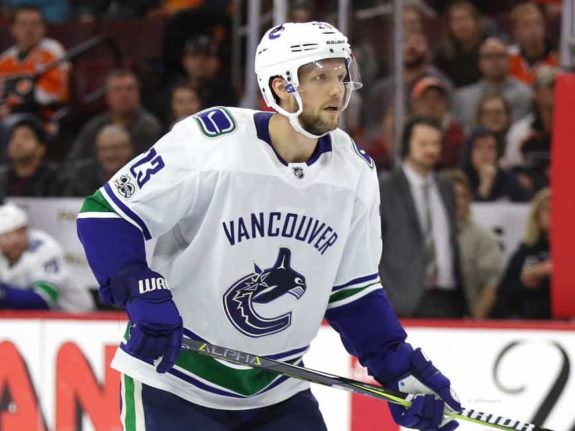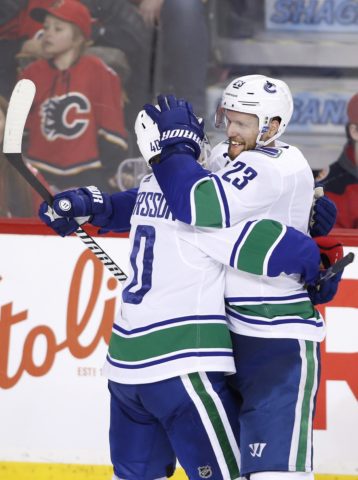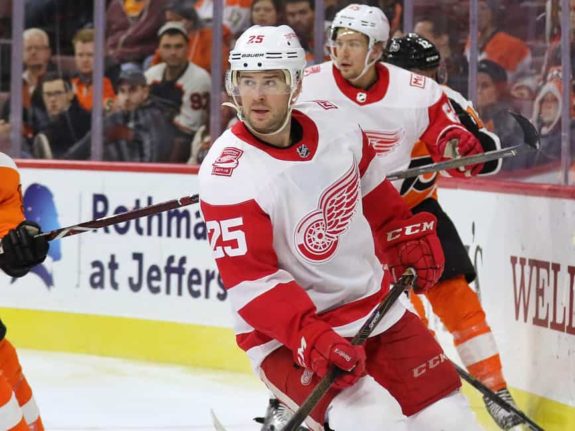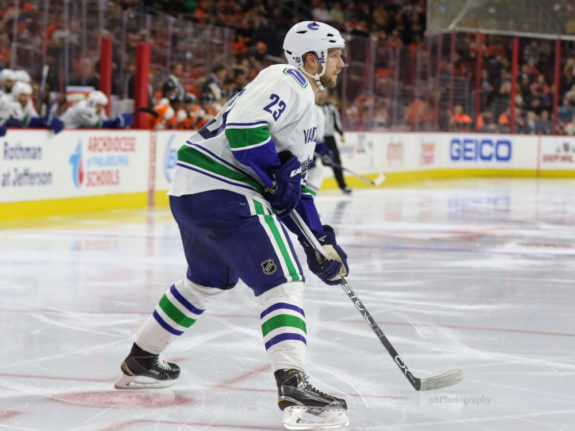Now less than five hours away, the trade deadline is fast approaching. But because Vancouver Canucks general manager Jim Benning is not expected to be very active today, a lot of focus in the Vancouver media over the weekend was placed on veteran defenceman Alex Edler who is set to become an unrestricted free agent (UFA) this summer.
A few days ago, TSN reported contract talks were progressing well with the 32-year-old, but since then there have been others who believe the two parties are still far apart.
Talks are at a standstill between Canucks and Edler but they can talk after trade deadline as well. I don't see Edler being traded by Monday deadline at all.
— Rick Dhaliwal (@DhaliwalSports) February 23, 2019
While I think it’s absolutely in the Canucks’ best interest to trade Edler before today’s deadline (the Pittsburgh Penguins would be a great fit considering they lost their two best defencemen on Saturday night), I agree with Sportsnet’s Rick Dhaliwal that it’s not going to happen.
First, Edler is still on injured reserve, and although it’s an encouraging sign that he skated on Sunday, a return to the lineup is not exactly on the horizon. Second, the Canucks value Edler extremely highly. He’s their best defenceman right now, having recorded over 350 points in his career — all with the Canucks — and he continues to play tough minutes in all situations. Most importantly, however, Edler is unlikely to be traded because he controls his own destiny due to the full no-trade clause in his contract.
Related: Canucks’ Trade Deadline Targets
All of this leads to the likelihood of an Edler extension, which of course doesn’t have to happen before the trade deadline, but given all the chatter could happen very soon. If they are indeed going to go down this road, there are a couple things that absolutely cannot happen if you’re Benning and the Canucks.
Avoid Giving Edler Too Much Term
If you’re the Canucks, the first thing you want to avoid is giving Edler a four or five-year contract. I’d even be hesitant to go three years, but it’s something I could live with, depending on the average annual value (AAV) and a couple other things.
The big Swede is already 32 and turns 33 in April. That’s the first reason. At his age, and with the number of minutes he plays, it’s not going to get any better from here on out. You can already see the decline in his five-on-five defensive play.

In 189 games played from 2013-16, the Canucks allowed 37.53 unblocked shot attempts per 60 minutes (FA/60) with Edler on the ice, the second-best number for defencemen on the team. That figure had Edler ranked 30th of 167 defencemen in the NHL who played at least 2,000 minutes during that time frame. In the last two and a half seasons — from 2016-19 — that number has risen to 43.1 FA/60, which ranks sixth on the Canucks and 100th of 160 defencemen who have played at least 2,000 minutes.
Offensively, while his point totals have remained very steady, his 10.46 individual shot attempts per 60 (iCF/60) are the lowest since his rookie season and his 2.29 scoring chances per 60 (iSCF/60) are the lowest since 2008-09.
The second, and more important reason, to avoid signing a long-term deal is his injury history. In addition to missing 24 of 62 games so far this season because of two separate injuries, Edler has only played in 74 per cent of Canucks games over the past six seasons (365 of a possible 492 games since 2013-14). The last time he played a full season was 2011-12.
Also, how quickly until two of Hughes/Hutton/Juolevi overtake Edler on the depth chart? Load up on AAV on a two year term. If there’s not a deal at two, flip him. If not that, I’d rather have Edler walk for nothing than sign a bad dealhttps://t.co/niSrEKrIzC
— Harman Dayal (@harmandayal2) February 22, 2019
For these reasons, a two-year deal with a higher cap hit is better than a three or four-year deal with a lower cap hit. If his sticking point is four years, let him walk. If his sticking point is three years, I’m okay with it, as long as the deal avoids certain clauses.
No-Move Clause a Non-Starter
Even more important than limiting the term on an Edler deal would be not giving him a no-movement clause.
As Jason Brough from The Athletic points out in the original tweet above, any player with a continuing and effective no-movement clause during the Seattle expansion draft will have to be automatically protected, which is the same rule that was in place for the Vegas Golden Knights expansion draft. That was why the Anaheim Ducks traded Shea Theodore to the Golden Knights. The Ducks were forced to protect an aging Kevin Bieksa instead of Josh Manson or Sami Vatanen, so they had to give up a young asset in Theodore in order for Vegas GM George McPhee to not select Manson or Vatanen, both of whom had to be left unprotected.

Being forced to protect Edler instead of one of Ben Hutton and Troy Stetcher (there’s a good chance Quinn Hughes and or Olli Juolevi will have to be protected) is not good. Remember, Edler will be approaching 35 by this time, so leaving him unprotected isn’t a big risk.
What the Canucks can do, however, is give Edler a no-trade clause. This is different than a no-movement clause. While a no-trade clause obviously offers trade protection, it does not prevent the team from demoting said player to the minors or putting him on waivers without his consent. None of those scenarios are likely to happen with Edler, but the distinction is important because players with a no-trade clause — even a full no-trade clause — do not have to be automatically protected in the expansion draft.
The Canucks can also get creative by offering Edler a no-movement clause in his first two seasons and then having it switch to a no-trade clause in 2021-22 (if Edler does indeed get his third year). This is because only no-movement clauses that are ‘continuing’ — meaning they carry into the Seattle franchise’s first season of 2021-22 — count.
It’s also not that uncommon for players to have a no-movement clause for only the first half or so of their total contract length. Marc-Edouard Vlasic and Brent Seabrook are two examples of players who have a no-movement clause switch to a modified no-trade clause in the last two or three years of their contracts.
Mike Green the Perfect Comparable
In the last three seasons, only three NHL defencemen have signed a contract extension at age 32 worth at least $5 million per season (what Edler currently makes): Brent Burns, Mike Green and Niklas Hjalmarsson. Burns is an elite defenceman, so let’s leave him out of the conversation. Green and Hjalmarsson, however, both represent an example the Canucks should follow.
This past summer, the Arizona Coyotes signed Hjalmarsson to a two-year extension with a $5 million AAV, a deal which kicks in next season. One day earlier, the Detroit Red Wings inked a similar two-year extension with Green — a deal with an AAV of $5.375 million. Clearly, a two-year extension is not out of the question.
Green is actually a perfect comparable for Edler because they have posted similar point totals at this stage in their careers and they share a lengthy injury history. (Green actually took a pay cut on his most recent deal, which is not necessarily something I expect for Edler).

Green first signed with the Red Wings as a UFA in the summer of 2015 for three years with an AAV of $6 million. In his three seasons in Detroit before signing his current deal worth $5.375 million per season, he posted 104 points in 212 games, or 0.49 points-per-game (P/G). He has also missed 57 games due to injury since 2015, suiting up for 81 per cent of Wings contests (additionally, Green hasn’t played a full 82-game season since 2007-08 and missed 118 games in his last five seasons with the Washington Capitals from 2010-15).
From 2015-18, the same time frame that Green posted 0.49 P/G, Edler posted 75 points in 190 games, or 0.39 P/G, while missing 54 games due to injury. Because of this comparable, I would would try to get Edler signed to something around $5.5-6 million for two years. While it’s probably unlikely given that Erik Gudbranson got $4 million per year for three seasons, it’s not impossible considering Green is making less and took a pay-cut.
Related: Luc Bourdon Remembered
Edler Contract Best-Case Scenario Vs. Reality
Earlier in this story, I referred to Dhaliwal reporting contract talks were “at a standstill.”
Jason Botchford from The Athletic said on Sunday he has heard term and money have been agreed upon, but that doesn’t mean Dhaliwal is wrong because the two parties are likely far apart with the structure (signing bonuses, clauses etc.) of the deal (from ‘The Athletties: The state of the rebuild, Edler’s contract and the draft picks proclamation’ – The AthleticNHL – 2/24/19).

The way I see it, here’s what’s best for both parties: convince Edler to sign for two years with an AAV of $6.5 or even $7 million, while rewarding him with a no-movement clause. This way, he won’t be automatically protected in the expansion draft because his contract will be up before Seattle begins play in 2021-22 and there’s no harm of a higher AAV the next two seasons because the Canucks are fine for cap space. It’s good for Edler because of the higher AAV and he gets a guarantee that he won’t be traded or put on waivers (should anything happen) during the entirety of the contract.
I have a feeling Edler won’t go for two years, which is why my guess is he will end up getting the same deal Green received in 2015 from the Red Wings: three years, $18 million, with a no-trade clause instead of a no-movement clause. While this isn’t a great scenario, it would at least mean the Canucks are not forced to protect him for the expansion draft and it would also avoid a four or five year commitment.
After all, if one thing is clear as day, it’s this: the worst-case scenario is Edler getting a big, fat extension which would add yet another bad contract to the Canucks payroll.